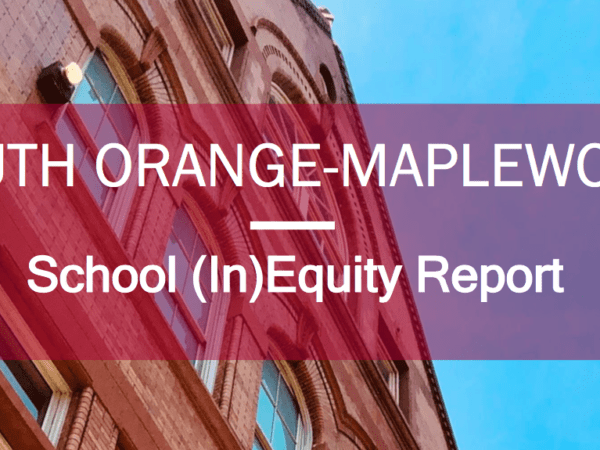From Black Parents Workshop:
The Black Parents Workshop, Inc., as part of its strategy related to its recently settled federal litigation, Black Parents Workshop, Inc. v. South Orange-Maplewood School District, commissioned Dr. Ryan W. Coughlan, an expert in geospatial statistical methods, to analyze the school district’s segregation and educational outcomes. Dr. Coughlan is an Assistant Professor of Education at Molloy College in Rockville Centre, New York. His research has been featured in The New York Times, The Philadelphia Inquirer, and on NPR’s All Things Considered. He has also served as a quantitative data expert in multiple school equity lawsuits.

[See the full report at the end of this article.]
Dr. Coughlan analyzed publicly available school district data, data from the New Jersey Department of Education, U.S. Department of Education Office for Civil Rights (OCR) data, and U.S. Census Bureau data to draw a distinct picture of the many challenges facing the South Orange-Maplewood School District and its two sending districts. Dr. Coughlan’s report confirms many of the concerns raised by the Black Parents Workshop over the last 6 years.
Dr. Coughlan notes, “The South Orange-Maplewood School District has the opportunity to take a leadership role in our nation’s long overdue reckoning with school segregation. Data presented in this report highlight a deeply inequitable school system in need of change. But with strong leadership, expert advisors, and committed community members, the South Orange-Maplewood School District can use this moment in its history to build an education system that is truly equitable and inclusive.”
Among the highlights in Dr. Coughlan’s South Orange-Maplewood School (In)equity Report: Historical Trends
• Up until the 2006-2007 school year, the district served a higher proportion of Black students than white students. Since that time, the Black student population has declined while the white student population has risen steadily. These trends continue to this day and show no sign of changing. In fact, during the 2018-2019 school year only 19.5% of first graders in the South Orange-Maplewood School District were Black. (p. 7)
Academic Outcomes
- Despite the fact that most subgroups in South Orange-Maplewood outperform statewide averages, there are a number of alarming achievement gaps within the district. Most notably is the achievement gap between Black and white students in the district.
- Furthermore, the fact that 94.6% of white students graduate from high school on time while only 85% of Blacks do must be addressed.
- Currently, only 67.9% of Black students are enrolling in college in the Fall after their high school graduation.
- Achievement gaps at the elementary school level are particularly stark.
- While the mean scale score on the third grade English Language Arts exam at Seth Boyden Elementary Demonstration School, where 23.8% of students are White students, 58.1% are Black and 44.2% are economically disadvantaged, is 743, the mean scale score on the third grade English Language Arts exam at Tuscan Elementary School, where 66.6% of students are White, 15.3% are Black, and 9.3% are economically disadvantaged, is 765.
Student Tracking and Leveling
- These inequities take shape at a young age, where certain students are classified as “gifted” and provided specialized services to advance their education. In the South Orange-Maplewood School District, the “gifted label” is closely tied to race.
- In 2015, 83% of students who were classified as “gifted” were white even though only 52% of the students in the district were white. Simultaneously, only 8% of students who were classified as “gifted” were Black even though 33% of students in district were Black.
Student Discipline
- It is important to note that the South Orange-Maplewood School District maintains an appalling racial disciplinary gap.
- While white students make up 52% of the district, they only receive 20% of the suspensions. Simultaneously, Black students receive 70% of suspensions despite only making up 33% of the district’s population.
- In 2015, Black students missed 510 days of schooling as a result of out-of-school suspensions. White students missed 92 days of schooling as a result of out-of-school suspensions.
Neighborhood Characteristics
- While most children living in the South Orange-Maplewood School District attend public school, 10.1% opt out of the public system and attend private schools. Many of these children are concentrated in northern and western portions of the district.
- In five of the census tracts [covering the School District], the Black population is below 25%. And in one of the census tracts, the Black population is above 75%. In four of the census tracts, the white population is above 75%. And in one of the census tracts, the white population is below 25%.
Dr. Coughlan makes a number of recommendations in his report that are directed at the goal of equity in the South Orange-Maplewood School District. Four of the most significant are:
- Develop a school assignment plan that maximizes diversity across all schools
- Conduct an in-depth equity and inclusion audit
- Terminate the system of leveling and tracking, and replace it with a detracking system that supports the equitable growth of all students
- Establish courses at all grade levels that specifically uplifts the voices of marginalized groups historically omitted from school curricula
Media outlets may request a full copy of Dr. Coughlan’s report by email: [email protected].
The report can also be downloaded at: www.blackparentsworkshop.org

